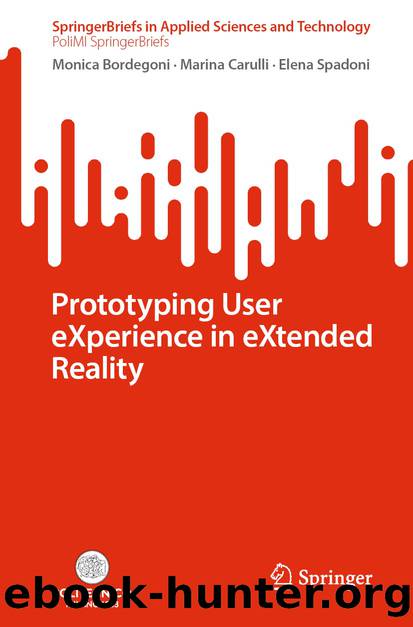Prototyping User eXperience in eXtended Reality by Monica Bordegoni & Marina Carulli & Elena Spadoni

Author:Monica Bordegoni & Marina Carulli & Elena Spadoni
Language: eng
Format: epub
ISBN: 9783031396830
Publisher: Springer Nature Switzerland
Olfactory Displays can take the form of wearable devices that are worn by the user or devices placed in the environment. Wearable ODs have the advantage of being able to present minimal amounts of scent stimuli as they are close to the user's olfactory field, but they can be bulky and inconvenient for the user. On the other hand, displays placed in the environment may not be noticed by the user until their olfactory sense is stimulated by the olfactory media component, but the delivery of olfaction can be significantly affected by the user's movements in the environment.
In the past few years, several ODs have become commercially available, some of which are integrated into headsets. For instance, the VAQSO scent device [56] can be attached to various Head Mounted Displays and has the ability to hold up to five replaceable scent cartridges. Another example is the FEELREAL scent generator [57], which is compatible with most HMDs and contains a replaceable cartridge with nine aroma capsules. Additionally, the OLORAMA digital smell simulator [58] can be placed in the environment and integrates up to ten realistic scents.
Carulli et al. [59] presented a study on using multisensory application, including the sense of smell, for virtual product testing. The virtual environment includes three virtual models of commercial washing machines arranged in a virtual room, and the study aims to evaluate various characteristics of the virtual products such as pleasantness of the product's shape and components, perceived usability, perceived value, and purchase intentions (Fig. 4.6). The participants experienced the washing machines alone and in combination with pleasant (lavender) and unpleasant (smoke) odors. The experimental test data analysis revealed that the use of scents had a positive impact on the usersâ experience of the virtual reality environment and the perceived level of presence. Additionally, the study found that the use of congruent and pleasant scents had a positive influence on the usersâ evaluations of the product's shape, perceived usability, and value.
Fig. 4.6 XR application for virtual product evaluation: a integrated HMD and OD; b virtual scenario
Download
This site does not store any files on its server. We only index and link to content provided by other sites. Please contact the content providers to delete copyright contents if any and email us, we'll remove relevant links or contents immediately.
Algorithms of the Intelligent Web by Haralambos Marmanis;Dmitry Babenko(8588)
Test-Driven Development with Java by Alan Mellor(7559)
Data Augmentation with Python by Duc Haba(7451)
Principles of Data Fabric by Sonia Mezzetta(7212)
Learn Blender Simulations the Right Way by Stephen Pearson(7139)
Microservices with Spring Boot 3 and Spring Cloud by Magnus Larsson(6960)
RPA Solution Architect's Handbook by Sachin Sahgal(6366)
The Infinite Retina by Robert Scoble Irena Cronin(6071)
Hadoop in Practice by Alex Holmes(6055)
Jquery UI in Action : Master the concepts Of Jquery UI: A Step By Step Approach by ANMOL GOYAL(5911)
Big Data Analysis with Python by Ivan Marin(5835)
Life 3.0: Being Human in the Age of Artificial Intelligence by Tegmark Max(5447)
Pretrain Vision and Large Language Models in Python by Emily Webber(4794)
Infrastructure as Code for Beginners by Russ McKendrick(4568)
WordPress Plugin Development Cookbook by Yannick Lefebvre(4282)
The Age of Surveillance Capitalism by Shoshana Zuboff(4192)
Functional Programming in JavaScript by Mantyla Dan(4170)
Embracing Microservices Design by Ovais Mehboob Ahmed Khan Nabil Siddiqui and Timothy Oleson(4061)
Applied Machine Learning for Healthcare and Life Sciences Using AWS by Ujjwal Ratan(4042)
